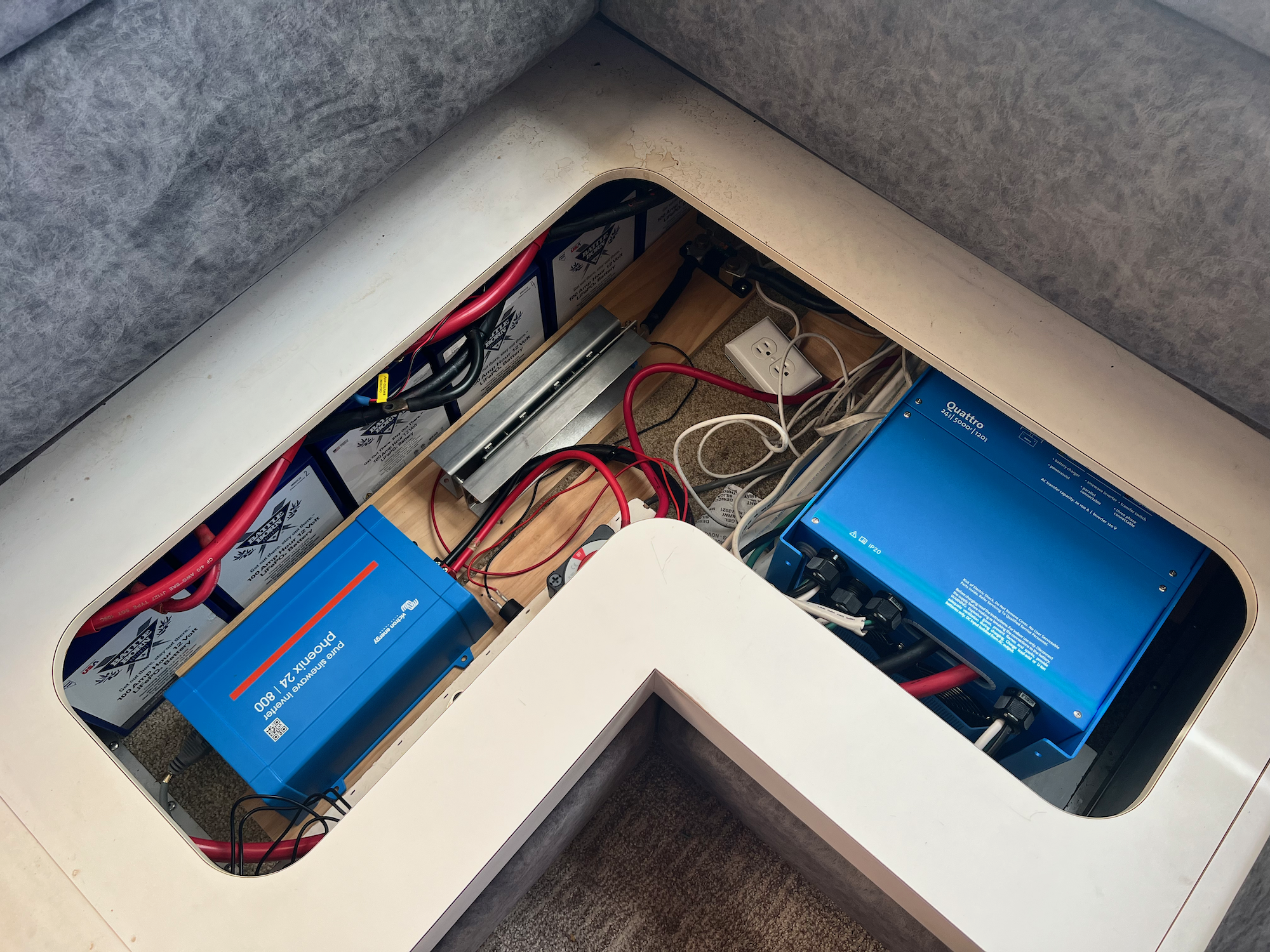
Our last post was on October 6 – just as we passed a previous record flood level from 1953 here at the waterfront in Downtown Sanford
Lake Monroe ended up cresting at 8.96′ above normal on October 9th, and the waters have been slowly receding since then. We’ve been living in flood conditions for 20 days now, without power for 15 days, and it’s been 3 weeks since Ian passed over us.
It’s been a tiring few weeks, but we’re hanging in there.
We’ve been embracing the surreal experience of having to wade ashore to do anything, living off-grid at the dock, duck and fish swimming at our feet, paddleboarding in the parking lot and helping stop slow down an invasive apple snail invasion.
We shared in our last post that we’re well suited for this sort of experience since we’ve designed for lots of anchoring out. We have solar, a generator, lithium batteries, large holding tanks and a composting toilet.
Sounds good right?
Yeah, it’s never as rosy as it could be. And sometimes it takes an emergent situation to make boat projects a priority.
Electrical Backstory
In 2018/2019 we installed our lithium & solar setup in our boat (see our post for documentation of that project).
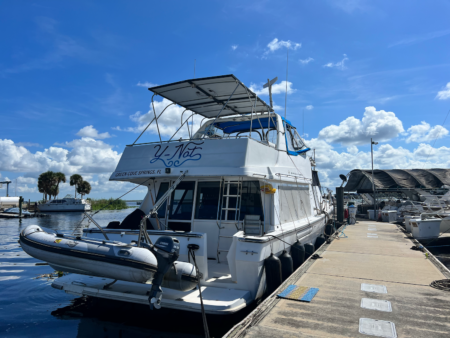
Late last spring, before we left out on our summer van trip, our Victron Quattro 24V inverter at the heart of our system just quit working. It would no longer charge or invert.
This is a crucial component of an electrical system – it’s what can charge our Battle Born lithium batteries off external power sources (like shore or generator), and what converts our 24 volt battery energy into power usable for our A/C loads (like air conditioning, computers, fridge, induction cooktop, ice maker and more).
Thankfully, the Quattro was only 4 years old and still covered by warranty – and Victron had us send it off for warranty repair.
Unfortunately, it was damaged in transit and Victron decided to not diagnose what had failed, and they told us they would just replace it.
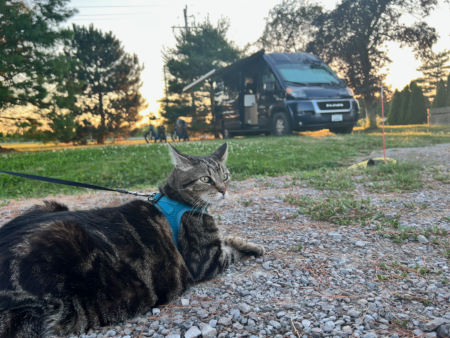
As we were just about to leave on our van trip and wouldn’t be here at the boat to receive and install the replacement, we opted instead to have them hold off until we got back.
So all summer long, our batteries could only be charged off of our solar – and shore power was required for all of our A/C loads.
Not an optimal situation, but it worked. Especially since we weren’t onboard using anything, only leaving a single air conditioner on for humidity control.
When we opted to cut our van trip short and head back to Sanford in September, I poked Chris to get the ball moving on getting the replacement inverter inbound.
I wanted to be prepared for possible anchoring out, or in case a hurricane hit…
Famous Last Words
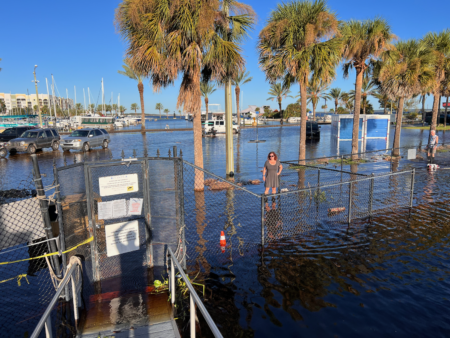
Why did I have to say ‘in case a hurricane hits’?
Not even a week back on the boat, and we found ourselves prepping for Hurricane Ian – before Chris had worked out the logistics to get the replacement inverter ordered in time.
We rode out Ian onboard, and we even kept power the entire duration of the storm, and for a few days afterwards. We thought we had cleared that hurdle.
But the 15″ – 20″ of rain that fell upstream eventually crept into the St. Johns River and caused record flooding along Lake Monroe.
When the water reached and flooded the transformer boxes here at our marina on October 5th, FPL turned off the power to the entire marina island.
Suddenly, our electrical situation was a lot more precarious without shore power.
As long as we had sunny days, our DC systems could stay on powered by solar and our Battle Born Lithium Batteries could stay charged. But if we needed to power anything on our AC circuits, we’d have to run the generator.
This sounds fine, until you consider that both our fridge and Dometic chest freezer are AC powered. Which means we would be having to run the generator a lot to keep our food from spoiling!
Running the generator hours every day is not just annoying – it would burn fuel that could not be easily replaced this south on the river, and which we will eventually need to get back down the river to Jacksonville.
With no idea how long the power would be out – we needed to jump into action.
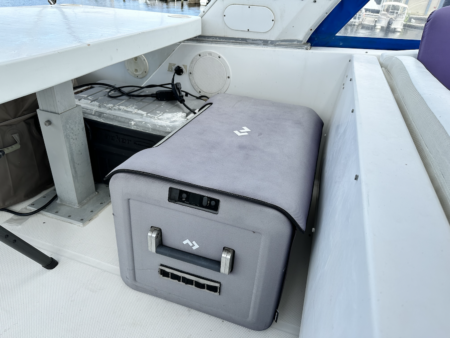
So the first thing Chris did was to finish (he had started this project well over a year ago!) wiring up our Dometic CFX3 chest freezer to run off of 24V DC so it runs on DC instead of AC now.
This meant that our freezer could run directly off of solar and battery.
He also added some DC-powered USB-C PD power outlets around the boat to keep our laptops charged.
We also used the freezer to make some ice bricks to help keep the fridge cold between generator runs too.
That took away some of the stress off of worrying about all of our perishable food.
Adding a Smaller Inverter
The next issue was our main fridge, which is a standard apartment sized residential fridge installed by Y-Not’s prior owner – replacing the original stock DC marine fridge.
We’ve debated for years whether we should switch back to a more power efficient 24V marine fridge that can run directly off the boat batteries. But ultimately, we decided that we’d like to keep a residential fridge (defrost! cheaper! more selection!) – and we’d instead get a smaller dedicated inverter to run it.
This would allow us to shut off the big Quattro much of the time, which has a large (35+ Watts!) phantom load, just for being turned on.
One of the biggest hits to our battery life aboard is because we have always had to leave the big inverter on 24/7 to power the fridge.
So when it seemed like this power situation was not going to be quickly resolved, we decided to jump on tackling the small inverter project ASAP.
Chris ordered a Victron Energy Phoenix 800VA 24v – a properly sized inverter that was available for overnight delivery, and which would keep our electrical chamber nicely color coordinated in blue. It only has a passive load of 7 Watts.
The Phoenix arrived the next day to our local friend’s address, as we couldn’t receive packages at the flooded marina office anymore (everything has been extra effort during this flood).
What I didn’t understand was how much work was involved with actually installing this upgrade. Note the multiple wardrobe changes during this project to get a sense of how long this took.
Moving circuits to run on the small inverter instead of the large one required tracing a lot of annoyingly unlabeled wires. Chris spent days head down in the circuit panel, tracking wires all around the boat.
But, we now have three circuits on Y-Not’s main breaker panel isolated so they can be powered by the secondary inverter. After this upgrade – we can have the fridge, bedroom outlets (for sleepy-time TV), and tech cabinet (for internet, including Starlink) powered 24/7 without leaving the big inverter on all the time.
It is a project that has been on the to-do list for years – but since it involved needing to spend so much time with all power to the boat shut down, it never was a priority.
But with all power now shut down by outside forces, well – might as well tackle it now!
It’s been a great upgrade that will benefit us for many years to come, and has gotten us through the power outage with far less frustration.
What about the Quattro?
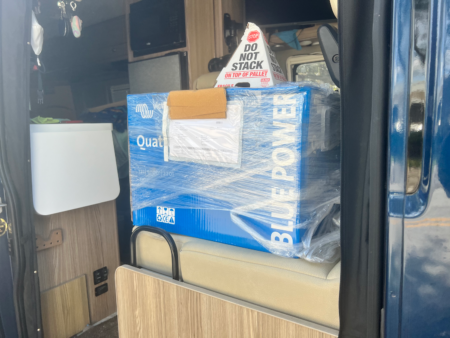
After the hurricane passed – we had Victron ship us the replacement Quattro.
But when it finally arrived nearly a week into our extended power-outage craziness (with much logistical challenges resulting from needing to meet up with a freight truck behind a McDonalds because of the flooded marina) – Victron had mistakenly sent the 12V model instead of 24V.
This mixup coincided with a 36-hour period of extended gloomy overcast, weather that our solar charging system and power draws just couldn’t keep up with.
We ended up draining our batteries and losing all DC power overnight one night, with no way to charge until the sun re-appeared.
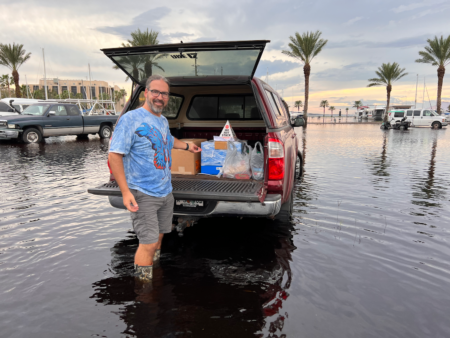
Chris quickly got the fridge switched back on the AC circuit so we could cool it off the generator again – but it was frustrating to be playing a constant game of juggling our power. We really needed a way to charge our batteries off of the generator!
Fortunately Victron was quick to get us the correct 24V model shipped to us – and this time it only took two days in transit.
Of course everything in a flood is more difficult, but we’re thankful to have use of a friend’s truck to drive through the flooded parking lot to get the box as close to the dock as we could – easing the journey to get the inverter aboard the boat.
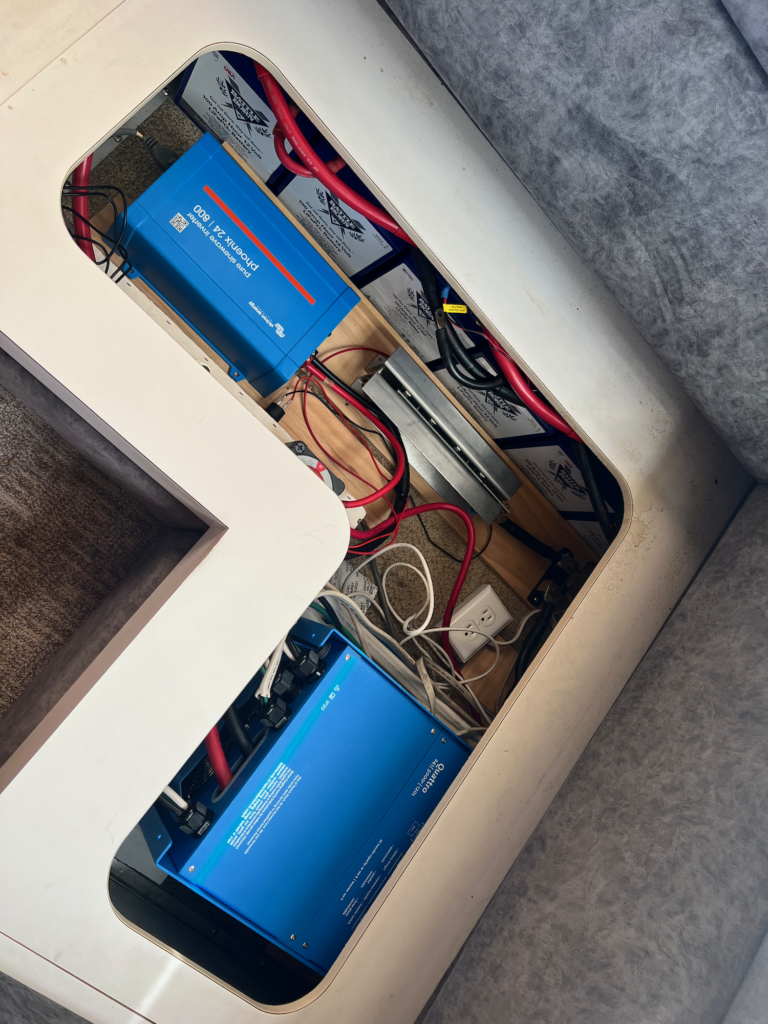
Chris got it all hooked up, and we finally have our electrical system back to normal and even upgraded.
It’s been freeing knowing we can now charge the batteries up off the generator if the sun doesn’t shine enough. And now we can also do things like cook without running the generator, thanks to having the big inverter back in action again!
Living Off Grid at a Dock
Thankfully the marina has allowed the water to be turned on a couple hours a day, so water rationing is no longer a concern. We even filled up the hot tub, but honestly haven’t been able to use it because of all of the mosquitos brought on by the nearby stagnant water.
We do still run the generator for a burst of air conditioning every afternoon, and for running the hot water heater every day or so for warm showers. And we even managed to run a load of laundry every few days, line drying outside on the flybridge.
So we’re doing pretty abundantly well now – 15 days into having no shore power.
The water is receding enough that FPL has just turned on power to this section of the waterfront.
Hopefully power to our docks can be restored too, as soon it passes inspection.
As of this evening, we no longer need our galoshes anymore to get into town!
This has certainly been quite the experience to navigate.
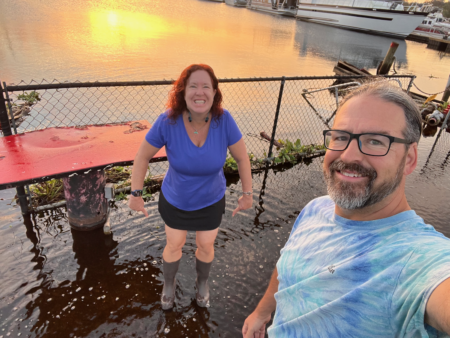
Three weeks of the storm and aftermath. The lake won’t return to ‘normal’ for at least another month.
All and all, we’ve done well and we’re incredibly thankful that things weren’t worse for us.
We have our floating home, we were well suited for handling it and we still had an amazing town close by for dining, entertainment, training for our marathon and meeting up with friends.
Cheers to drier conditions ahead!
YouTube Extras
In the past few weeks we’ve shared some content from the flooding on our YouTube channel if you’d like to further experience it.
First, a 3 minute montage of drone video Chris took:
Live broadcast archives:
Tour of the Flooding at the Crest



















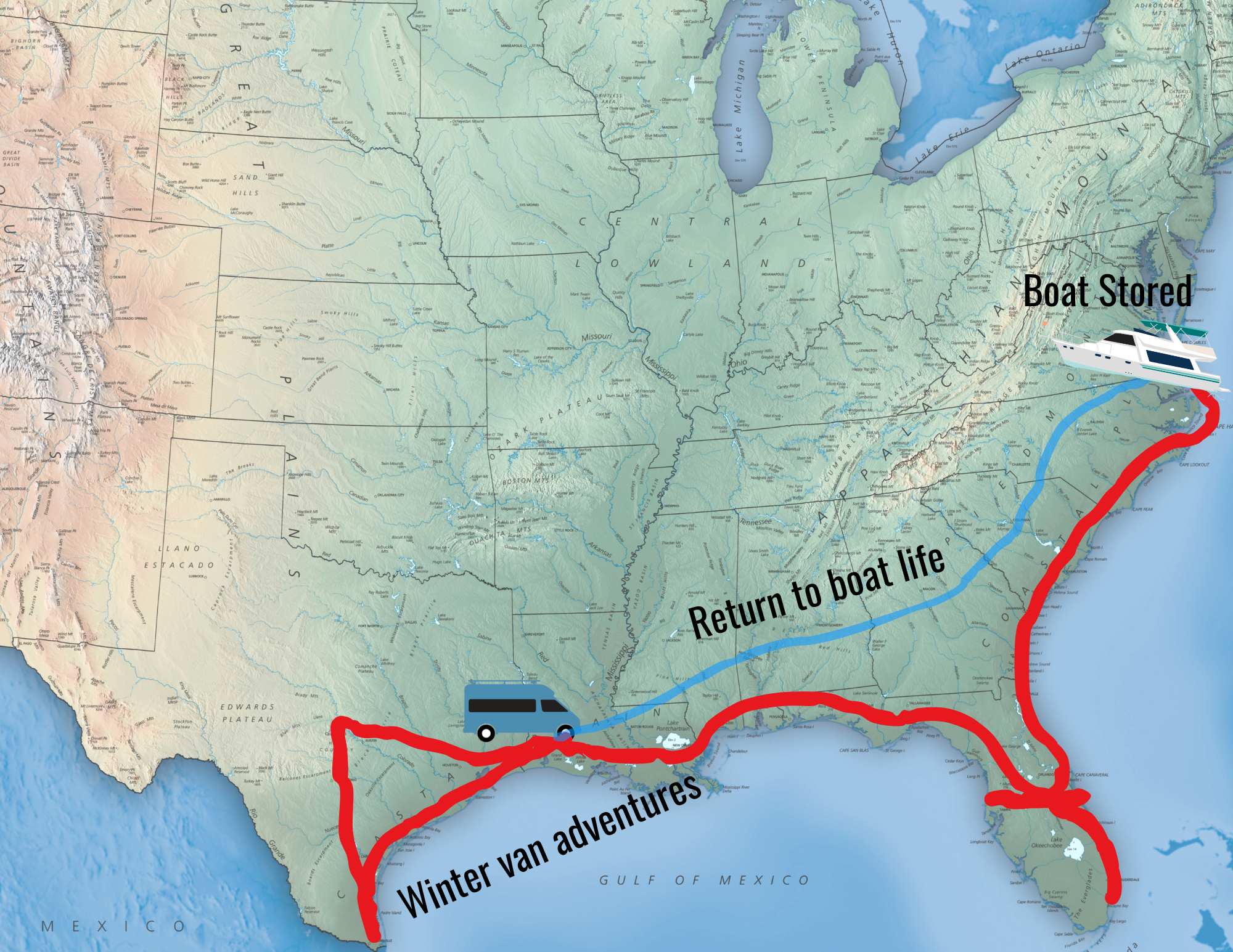
What a wild experience! Prince Edward Island lost power after Fiona and we got to spend 14 days in our apartment without any heat or cooking source. It made us miss the RV days for sure! I’m so glad you’re doing okay and will now be better than ever moving forward.
Glad things are getting back to “normal”. Nice move on the smaller Victron inverter – those are super efficient. It really is remarkable they have so little idle draw. Cherie, I do not always comment, but I always enjoy your posts…..you are a very good writer.
My wife wants us buy a house boat. I could follow what you did (very impressive) but no way could I do this. Since retirement I have let my tech skills slip. Oh well.
Nothing like an emergency to get some of those pesky jobs completed. Well done guys!
Riding out Hurricane Ian was quite an adventure. I appreciated the video that took us along with you during the storm. Amazing that Kiki slept through most of it. Unbelievable that ducks and fish are sharing the parking lot with everyone. I did hear that the St. John River might have flooding and wondered if you were all okay. Great that you and Chris have the skills to innovate and handle any crises. Thank you so much for keeping us advised that you are doing okay. What an adventure this must be. Be well and take good care of yourselves.
You both had done amazingly well with the circumstances you’re living in. Way to go!
We all have talents . Being handy and being able improvise on a boat,rv, or a fixed home saved a great deal of labor costs. Where did Chris get his electrical talents?
So glad you guys are making it through. I feel your pain on wire tracing. We’ve done a lot of that this past year during our 30->50A upgrade.
Hi, for mission critical I prefer to have 2 inverter/chargers. If one goes I’m only on reduced power. I’m glad Ian is no longer such a problem.
Always good to hear from you two. Jeanne and I refer to SIGMACHI as “our condo on the water” due to the constantly riising fuel costs!
You are doing great! Keep everyone posted!